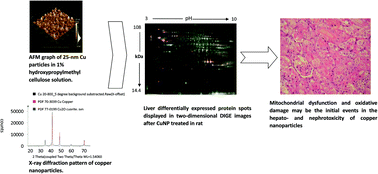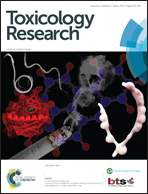Mitochondrial dysfunction and oxidative damage in the liver and kidney of rats following exposure to copper nanoparticles for five consecutive days†
Abstract
Objective: The goal of the current study was to investigate the molecular mechanisms of copper nanoparticle (CuNP)-induced hepato- and nephrotoxicity by a proteomic analysis that was phenotypically anchored to conventional toxicological outcomes. Methods: We employed specialized proteomic techniques, namely two-dimensional difference gel electrophoresis coupled with mass spectrometry to analyze the changes in protein expression in rat liver and kidney after 5 days of oral copper nanoparticle administration. Serum biochemical analyses and histopathological examinations of livers and kidneys of all rats were also performed. Results: All of the results indicated that the adverse effects observed in the rats treated with 100 mg kg−1 d−1 nanocopper were less than those induced by 200 mg kg−1 d−1 CuNPs. Exposure to CuNPs at a dose of 200 mg kg−1 d−1 for 5 d can induce overt hepatotoxicity and nephrotoxicity through a mechanism that mainly involves scattered dot hepatocytic necrosis and widespread renal proximal tubule necrosis. In addition, significantly elevated copper accumulation, decreased thiol groups and elevated malondialdehyde levels were also observed in the liver and kidney tissues. The perturbed proteins identified in the rat livers and kidneys are mainly involved in the respiratory and energy metabolisms, antioxidant defense, phase II metabolism, lipid metabolism, urea cycle, creatine biosynthesis, intracellular calcium homeostasis, and cytoskeletal organization. No abnormalities were identified in the liver and kidney tissues from the rats treated with 200 mg kg−1 microcopper. Conclusions: The results of this study suggest that mitochondrial dysfunction and oxidative damage may be the initial events in the hepato- and nephrotoxicity of copper nanoparticles. The down-regulation of phase II metabolic enzymes in the liver and the decrease in calcium-binding proteins in the kidney appear to be specific modes of action in these target organs. Our findings offer new directions for future research aiming to identify the specific biomarkers of the hepatotoxicity and nephrotoxicity of copper nanoparticles.


 Please wait while we load your content...
Please wait while we load your content...